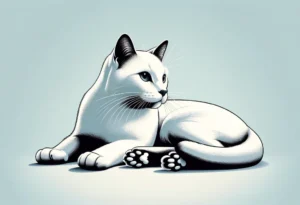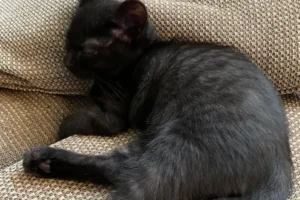Have you ever wondered why some cats are orange? The answer lies in their genetics and unique coloration patterns.
Orange Cat Genetics:
How do cats get their fur color?
Cats get their fur color from specific genes inherited from their parents. These genes come in pairs, with one coming from the mother and one from the father. The combination of these genes determines the color and pattern of a cat’s fur.
When a gene for orange fur color is present, it dominates over other colors such as black or brown. This is why cats with the orange gene will have primarily orange fur, though the shade may vary. If a cat receives two copies of the orange gene, it will have a richer, deeper orange color.
Interestingly, the genetics of fur color can be quite complex, with multiple genes influencing the final outcome. This is why you may see variations in orange cats, from pale cream to vibrant ginger. The interplay of genes passed down through generations can result in a wide array of shades within the orange spectrum.
What causes the orange color in cats?
The specific gene responsible for the orange color in cats is called the “O” gene, also known as the orange gene. This gene is located on the X chromosome, making it a sex-linked trait. Female cats have two X chromosomes, so they can have two copies of the orange gene (XX), resulting in a more intense orange color. Male cats, however, have only one X chromosome, so a male cat needs only one copy of the orange gene (XY) to display orange fur.
It’s interesting to note that the orange gene is a recessive gene, meaning that it must be present in both pairs to show its color. If there is only one copy of the orange gene present, it will be overshadowed by other color genes, resulting in a different-colored cat. This is why not all cats with one orange parent are orange themselves.
In addition to fur color, the orange gene can also affect other aspects of a cat’s appearance, such as eye color and coat pattern. This gene plays a crucial role in determining the unique and beautiful orange hues seen in many felines.
Are all orange cats the same shade?
Not all orange cats are the same shade! In fact, orange cats can vary in color from a light ginger to a deep red. This variation in shade is due to genetics, with some cats inheriting a lighter, more muted orange coat, while others may have a darker, more vibrant hue. This genetic diversity among orange cats adds to their charm and uniqueness.
Can two orange cats have non-orange kittens?
While it’s rare, two orange cats can produce non-orange kittens. This is because the orange color in cats is a result of a specific gene (the O gene) that determines their coat color. If both orange cats carry other color genes, they can pass those genes on to their offspring, resulting in kittens with a different coat color. So, even if both parents are orange, there is a chance that some of their kittens may not be orange.
Fun Facts About Orange Cats: – Orange cats are often referred to as “ginger cats” due to their resemblance to the color of ginger root. – Male orange cats are more common than female orange cats, with the orange gene located on the X chromosome. – Famous orange cats in pop culture include Garfield, Puss in Boots from Shrek, and Simba from The Lion King. So, if you’re a fan of orange cats, you’re in good company! – Orange cats are believed to bring good luck and prosperity in many cultures, making them a popular choice for pet owners looking for a little extra positivity in their lives.
Famous orange cats in pop culture
In pop culture, orange cats are often portrayed as charismatic and endearing. One famous orange cat is Garfield, known for his love of lasagna and his sarcastic attitude. Another well-known orange cat is Hobbes from the comic strip Calvin and Hobbes, who is depicted as a wise and loyal companion to Calvin. Additionally, the Cheshire Cat from Alice in Wonderland is a whimsical and mysterious orange feline character. These iconic orange cats have captured the hearts of audiences worldwide with their unique personalities and charming quirks.
Orange tabby cat personality traits
Orange tabby cats are known for their friendly and outgoing nature. They tend to be sociable and affectionate, enjoying human interaction and forming strong bonds with their owners. These cats are often described as playful and curious, with a mischievous streak that adds to their charm. Orange tabbies are also known for their intelligence and adaptability, making them excellent companions for households of all kinds. Overall, orange tabby cats are a delightful mix of playful energy and affection, bringing joy and warmth to their families.
Common personality traits of orange tabby cats:
- Friendly: Orange tabby cats are known for their sociable nature and love of human companionship.
- Playful: These cats have a playful and energetic demeanor, always ready for a game or some fun.
- Curious: Orange tabbies are naturally curious and enjoy exploring their surroundings.
- Affectionate: They are often quite loving and enjoy cuddling with their owners.
- Intelligent: Orange tabby cats are smart and quick learners, making training sessions easier.
- Adaptable: They are adaptable to different environments and tend to adjust well to changes.
Embrace the unique personality of your orange tabby cat and enjoy the special bond you share with this vibrant and lovable feline companion.
Myth-busting: superstitions about orange cats
Let’s debunk some myths and superstitions surrounding orange cats. One common misconception is that orange cats are more aggressive than cats of other colors. In reality, a cat’s personality is not determined by its fur color but rather by its individual temperament and upbringing.
Another superstition is that orange cats bring bad luck. This belief likely stems from old folklore, but there is no scientific basis to suggest that orange cats are unlucky. In fact, many orange cats are beloved companions and bring joy to their owners.
One myth that we can definitively bust is that orange cats are all male. While it is true that the majority of orange cats are male, there are plenty of female orange cats as well. The orange color gene is carried on the X chromosome, so male cats only need one orange gene to display the color, while females need two.
Remember: Colors have no impact on a cat’s behavior or luck; each cat is unique regardless of their fur color.
Unique markings in orange cats
Orange cats can have a variety of unique markings that make them truly distinctive. Some orange cats have tabby stripes, which can come in various patterns like classic, mackerel, or ticked tabby. These stripes may be bold and prominent or more subtle, giving each cat a one-of-a-kind look.
Solid orange cats, also known as marmalade cats, have a uniform orange color without any stripes or spots. This solid coloration can vary in shade from light cream to deep red, creating a visually striking appearance. Additionally, some orange cats may have white markings on their chest, paws, or face, adding extra charm to their look.
Fun Fact: Orange cats are often called “ginger cats” in the UK, inspired by the warm hue of ginger root.
Alex, a passionate animal lover, has experience in training and understanding animal behavior. As a proud pet parent to two dogs and three cats, he founded AnimalReport.net to share insights from animal experts and expand his knowledge of the animal kingdom.




